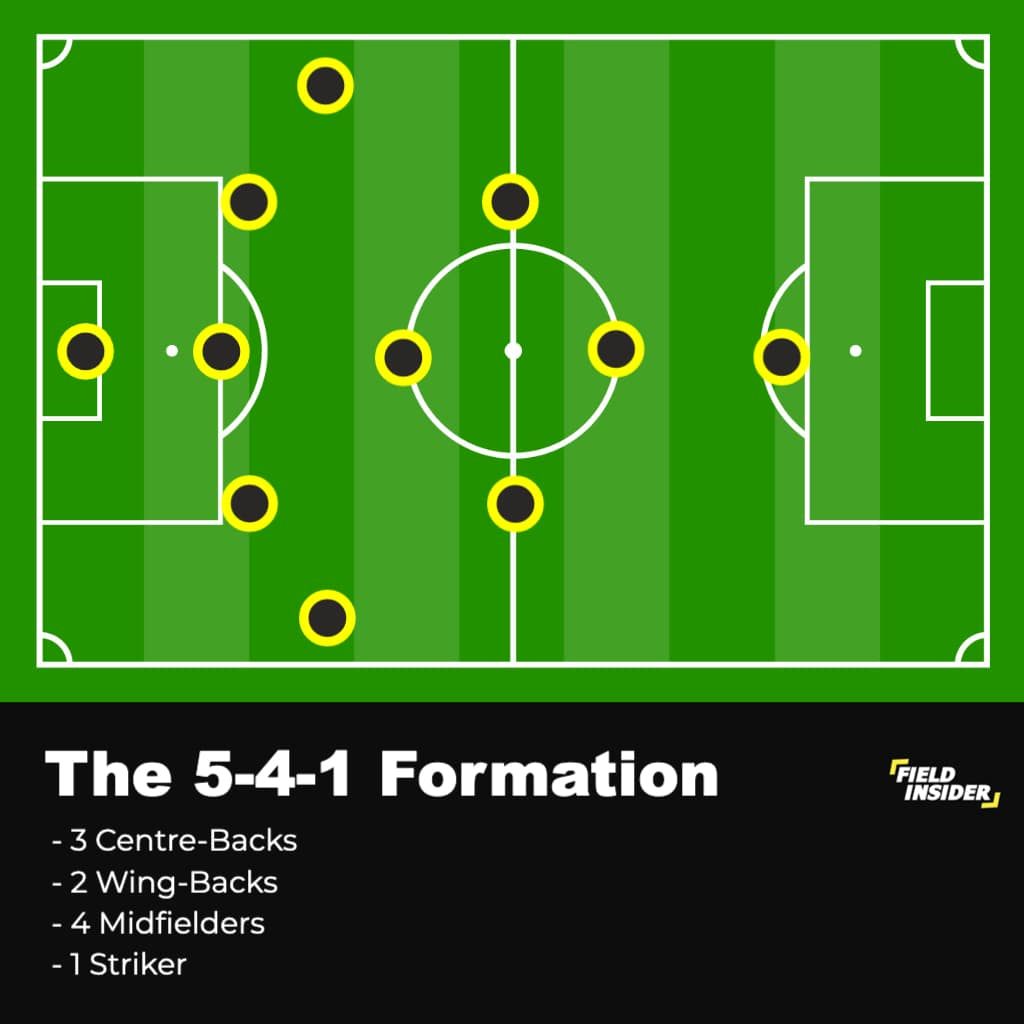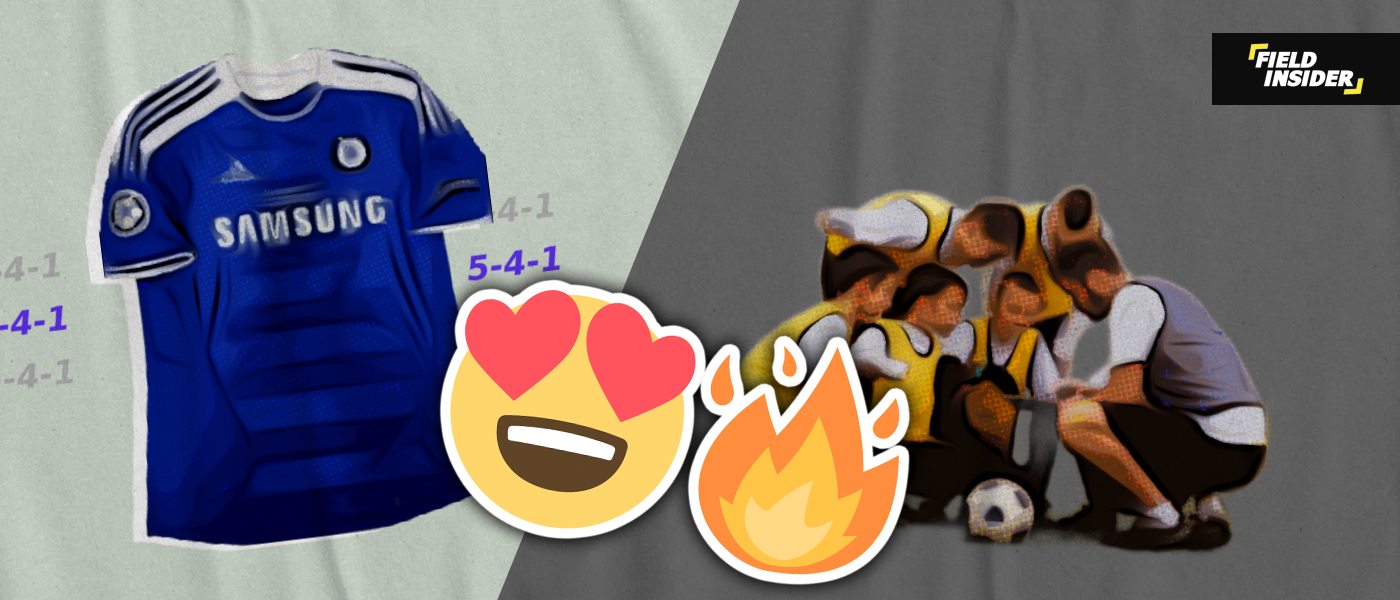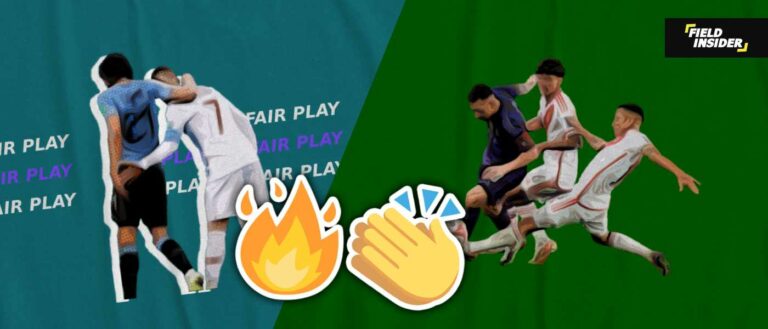The 5-4-1 Formation: Complete Handbook
The 5-4-1 soccer formation is an effective strategy that mixes strong defense with quick attacks. This guide goes deep into how the 5-4-1 works, talking about where players stand, what their jobs are, the good stuff about this setup, and the tricky parts too.
This comprehensive guide delves into the intricacies of the 5-4-1 setup, shedding light on its layout, player roles, strategic advantages, and areas of vulnerability. Understanding the 5-4-1 formation offers a pathway to achieving strategic depth and success on the pitch.
Key Takeaways
| Section | Key Takeaways |
|---|---|
| Understanding the Basics of the 5-4-1 Formation | Focuses on strong defense and quick counterattacks, with players having clear roles. |
| Advantages of the 5-4-1 Formation | Offers a solid defense, effective counterattacks, and the ability to control the midfield, making it tough for opponents. |
| Potential Weaknesses of the 5-4-1 Formation | Can limit attacking options and be vulnerable to wide attacks, requiring careful management and player discipline. |
| Tactical Variations and Adjustments | Adjustments like more attacking wing-backs or shifting to a formation with more forwards can help address in-game challenges. |
| Famous Examples of Teams Using the 5-4-1 Formation | Teams like Chelsea in their 2012 Champions League win and Iceland in Euro 2016 successfully used the 5-4-1, showcasing its effectiveness at high levels. |
| Tips for Coaches and Players | Emphasizes the importance of specific training drills for defensive shape and communication strategies to enhance team performance in the 5-4-1 formation. |
Understanding the Basics of the 5-4-1 Formation

Formation Layout and Player Positioning
In the 5-4-1 formation, the defense is comprised of three central defenders flanked by two wing-backs. This setup provides a robust defensive line against attacking threats. The midfield four are tasked with both defensive duties and initiating attacks, creating a bridge between the defense and the striker.
This lone striker plays a crucial role in holding up the ball and laying it off to onrushing midfielders or wing-backs. The positioning is strategic, designed to exploit counterattacks effectively.
Defensive and Offensive Responsibilities of Each Player
Each player in the 5-4-1 setup has clearly defined roles. The central defenders are the last line of defense, concentrating on neutralizing direct threats. Wing-backs operate with dual responsibilities: they bolster the defense and provide width in attacks.
This dual role is pivotal where wing-backs are essential in balancing the team’s shape. Midfielders, the formation’s engine, aids the defense and crafting attacks. The lone striker, although isolated, holds a key role in controlling the ball and enabling midfielders and wing-backs to join the offensive play.
Advantages of the 5-4-1 Formation
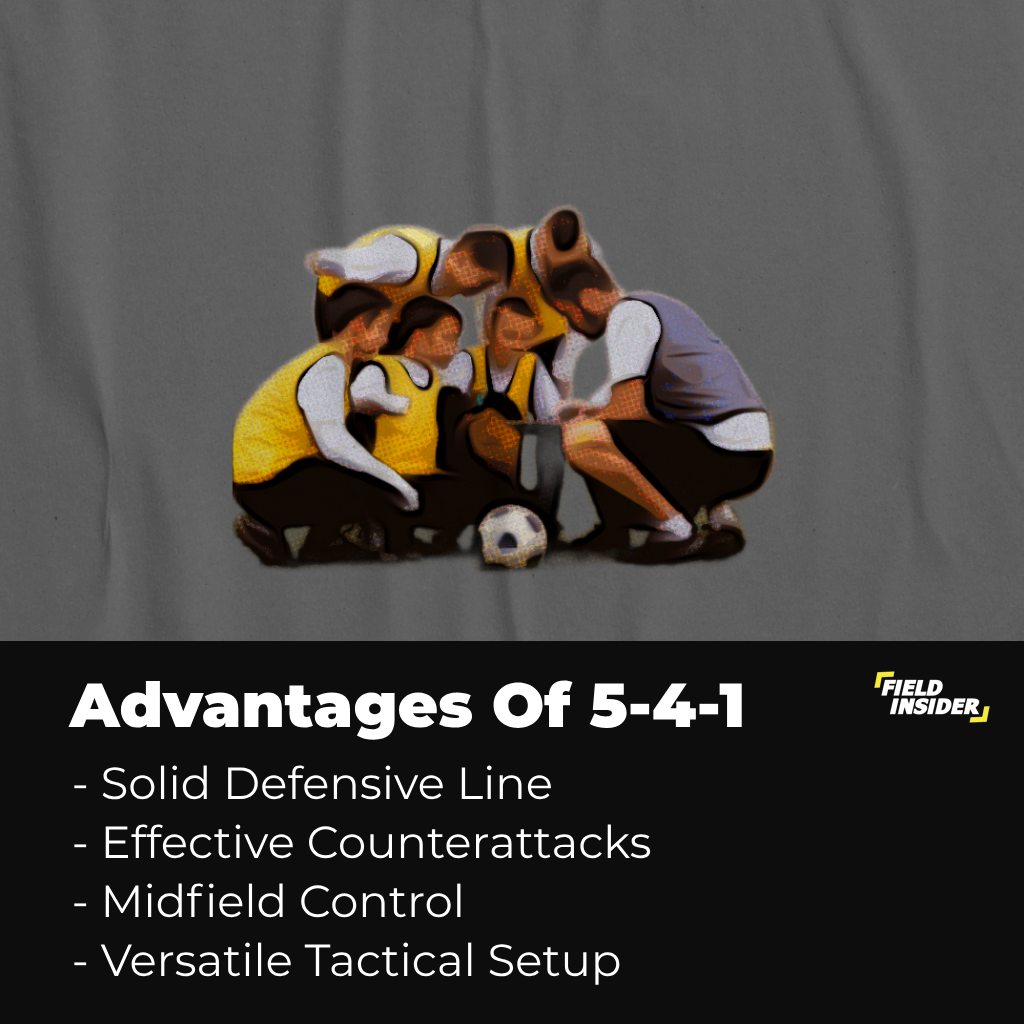
Solid Defensive Structure
The cornerstone of the 5-4-1 formation is its formidable defensive line, crafted through the deployment of five dedicated defenders. This arrangement significantly reduces the spaces available for opponents to exploit, particularly in central areas, making it exceedingly difficult to navigate through the defense.
It’s an effective strategy against teams that rely heavily on central forward play or possess dominant central attacking midfielders. The defensive solidity provided by the 5-4-1 is a testament to the adage that a strong defense is the best foundation for success.
Effective Counterattacking Opportunities
One of the most striking advantages of the 5-4-1 formation is its ability to transition rapidly from defense to offense. This is achieved by utilizing the pace and agility of the wing-backs, coupled with the strategic positioning of midfielders and the lone striker, to exploit spaces left by the opposing team’s attacking ventures.
The formation is particularly lethal against opponents that commit many players forward, leaving themselves vulnerable to quick counterattacks. This approach not only disrupts the rhythm of the opposing team but also provides a platform for scoring goals from limited possession.
Ability to Control the Midfield
Despite its primary focus on defense, the 5-4-1 formation is surprisingly effective at controlling the midfield. This is achieved through the disciplined positioning of the four midfielders, who are tasked with both defensive duties and facilitating transitions into attack.
The midfield quartet’s ability to press opponents, intercept passes, and initiate counterattacks is crucial for disrupting the opposition’s gameplay and maintaining control over the match. This midfield dominance allows teams to dictate the pace of the game, making it easier to implement their plans.
Potential Weaknesses of the 5-4-1 Formation
Limited Attacking Options
The primary challenge of the 5-4-1 formation lies in its offensive limitations. With only one striker and a midfield primarily focused on defensive duties, creating scoring opportunities can be challenging. This issue becomes more pronounced when facing teams that excel in maintaining possession.
The reliance on counterattacks and long balls to the lone striker can become predictable, making it easier for well-organized defenses to neutralize the threat. Teams using the 5-4-1 must find creative ways to support their striker and diversify their attacking methods to overcome this limitation.
Vulnerability to Wide Attacks
Although the 5-4-1 is solid centrally, it can be susceptible to attacks from the flanks. Teams with pacey wingers and full-backs who are adept at delivering crosses into the box can stretch the five-man defense. This creates spaces and mismatches to exploit.
This vulnerability requires the wing-backs in the 5-4-1 to work tirelessly, balancing their offensive contributions with the need to track back and defend against wide attacks. Ensuring the midfielders are also ready to provide cover and support to the wing-backs is essential for minimizing this weakness.
Tactical Variations and Adjustments

Utilizing Wing-Backs for Additional Width
One common adjustment involves giving the wing-backs a more pronounced offensive role. This shift can inject additional width and dynamism into the team’s attacking play. It provides alternate routes to goal beyond direct counterattacks.
By pushing higher up the pitch, wing-backs can offer cross-field passes, overlaps, and crosses, creating numerical advantages and confusion among opposing defenders. This adjustment, however, requires meticulous balance to avoid leaving the team exposed to counterattacks.
Transitioning to a More Attacking Formation
Another strategic variation entails shifting to a more attacking formation during the game. This could involve moving from a 5-4-1 to formations like the 4-3-3 or 3-4-3, adding more personnel to the attacking phase.
Such a transition might be prompted by a need to chase the game or exploit particular weaknesses in the opposition’s setup. Players must be versatile and tactically aware, capable of adapting to new roles and responsibilities on the fly.
Famous Examples of Teams Using the 5-4-1 Formation
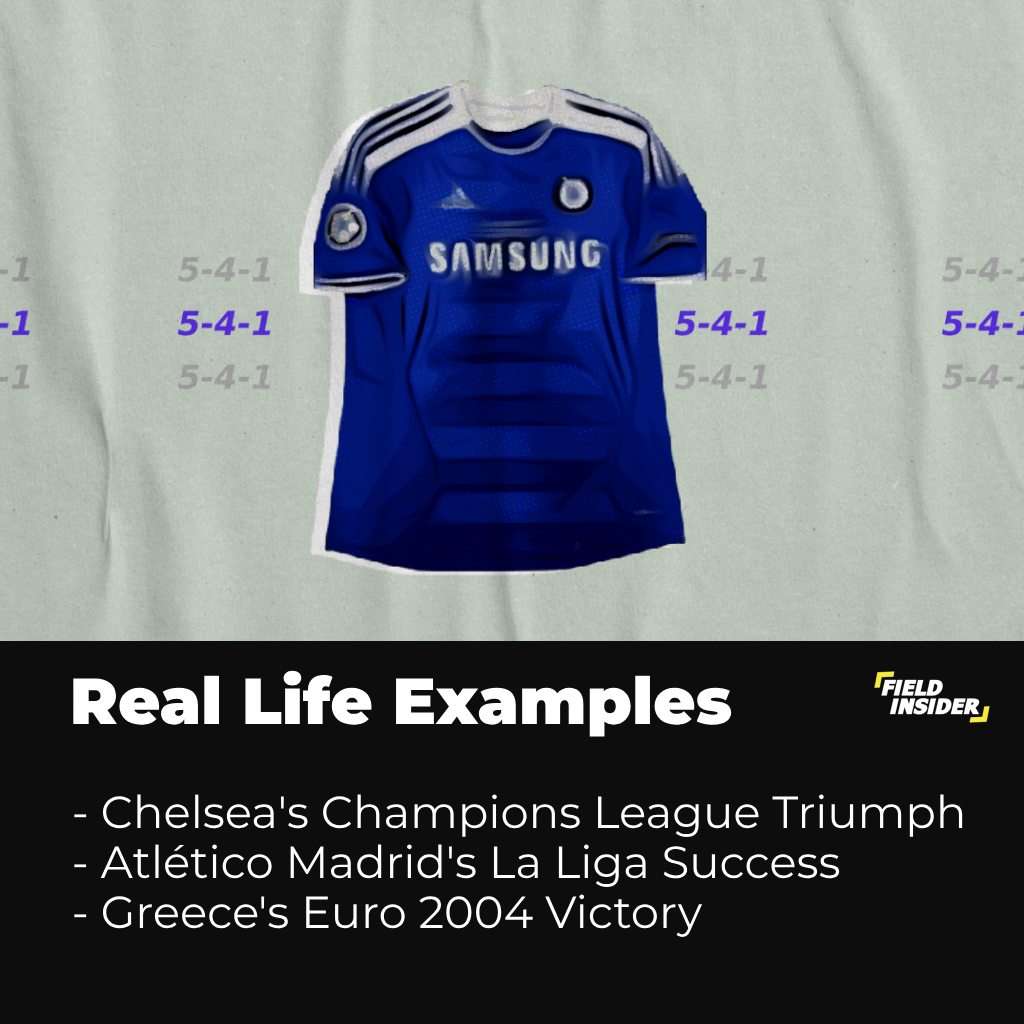
Chelsea’s Champions League Triumph
Chelsea’s utilization of the 5-4-1 formation under manager Roberto Di Matteo in 2012 is a prime example of the setup’s defensive prowess. In their Champions League campaign, Chelsea adopted a disciplined defensive approach, emphasizing solidity at the back and efficiency in counterattacks.
This strategy was pivotal in their victory against Bayern Munich in the final, where Chelsea’s robust defense and clinical counter-attacks allowed them to secure the title against the odds.
Atlético Madrid’s La Liga Success
Atlético Madrid, under Diego Simeone, has frequently utilized the 5-4-1 formation to great effect. Simeone’s tactical discipline and emphasis on a strong defensive unit have made Atlético a formidable opponent in both domestic and European competitions.
The 5-4-1 has been central to Atlético’s ability to stifle more possession-oriented teams. It allows them to compete against and often defeat wealthier clubs with more attacking prowess.
Greece’s Euro 2004 Victory
Perhaps the most famous example of the 5-4-1 formation’s success is Greece’s unexpected triumph at Euro 2004. Under coach Otto Rehhagel, Greece employed a highly disciplined 5-4-1 setup, focusing on defense while exploiting rare counterattacking opportunities.
This approach led them to victory against several footballing giants, including hosts Portugal in the final. Greece’s win remains one of the most remarkable underdog stories in football history. It illustrates the 5-4-1 formation’s potential to level the playing field.
Tips for Coaches and Players

Training Drills to Optimize Defensive Shape
| Drill | Objective | Description |
|---|---|---|
| Backline Coordination Drill | Enhance communication and positioning among defenders. | Players practice moving as a unit, adjusting their positions based on ball movement and simulated attacks. |
| Pressure and Cover Drill | Teach defenders how to apply pressure and provide cover effectively. | One defender applies pressure on the attacker while others adjust to cover spaces and potential passing lanes. |
| Transition to Counter Drill | Improve quick transitions from defense to offense. | This drill simulates scenarios where the team wins the ball back and immediately initiates a counterattack. |
| Set Piece Defensive Training | Strengthen defense against set pieces. | Focuses on organizing the defensive structure during corners and free-kicks, ensuring tight marking and effective clearance. |
| Spatial Awareness Exercise | Develop defenders’ awareness of space and positioning relative to the ball and each other. | Involves exercises where defenders must maintain an optimal distance from each other and the ball, adjusting as the scenario changes. |
These drills are designed to enhance the defensive capabilities of teams utilizing the 5-4-1 formation.
Key Communication Strategies for Effective Teamwork
Effective communication is the backbone of executing the 5-4-1 formation successfully. Coaches should cultivate an environment where players feel comfortable communicating openly and clearly on the pitch. This involves not just verbal cues but also non-verbal signals and body language.
Implementing communication drills can enhance understanding among players, ensuring that transitions between defensive and offensive phases are seamless. Encouraging a culture of continuous feedback and discussion among teammates can further refine the execution of the 5-4-1 formation.
Tactical Formations Influencing Forward Play: A Study in Soccer Dynamics
The study, titled “The influence of tactical formation on physical and technical match performance in professional soccer,” provides insights into the varied demands placed on forwards depending on their team’s formation.
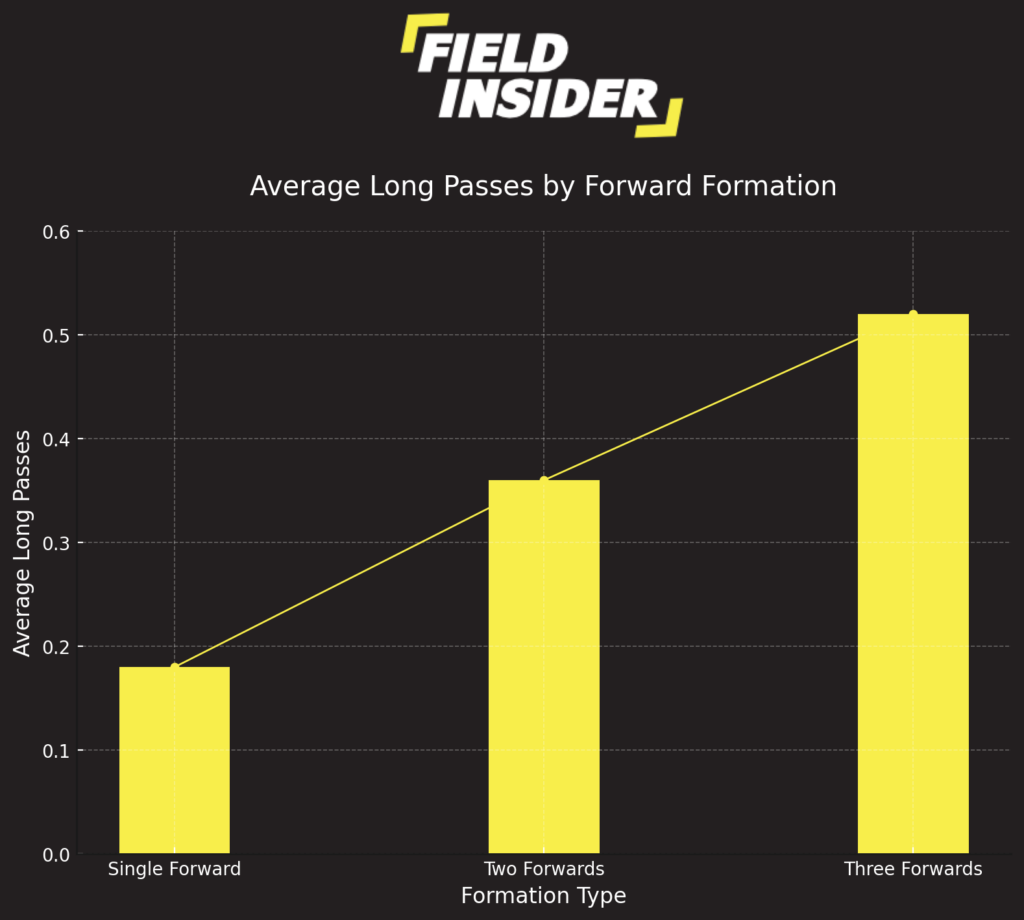
A striking takeaway from the research is illustrated in the accompanying chart. It shows that forwards in a single striker formation average 0.18 long passes, less than those in two or three-striker setups. In formations with two forwards, this average rises to 0.36, and it peaks at 0.52 for formations with three forwards.
Linking this to the defensive-minded 5-4-1 formation, which typically employs a single forward. The study underscores the formation’s lower emphasis on long passing. This insight is essential for teams to tailor their training and match-day tactics effectively.
Conclusion
In conclusion, the 5-4-1 soccer formation presents a strategic blend of defensive stability and counterattacking prowess, tailored for teams aiming to strike a balance between safeguarding their half and exploiting offensive opportunities.
Its successful application by renowned teams underscores its viability at the highest levels of competition. Nonetheless, unlocking the formation’s full potential hinges on rigorous training drills, effective communication, and the ability to dynamically adjust to the flow of the game.
These requirements emphasize the need for a cohesive team effort and a nuanced understanding of soccer’s tactical intricacies. This makes the 5-4-1 a testament to the sport’s rich strategic landscape.
What is the 5-4-1 Formation?
“Is 5-4-1 a good formation?” is difficult to answer unless you know the basic setup of the formation.
The 5-4-1 is a fairly complicated formation with numerous variations that alter the appearance of the formation fairly significantly. Here we will explain the most commonly used variation. But we will go over all the variations in a later paragraph.
In defence, the 5-4-1 has three central defenders with two wing-backs. In midfield, there is one defensive midfielder, two central midfielders and one attacking midfielder.
